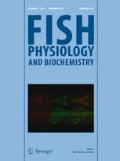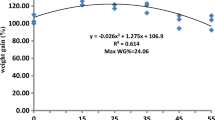Abstract
This study was carried out to establish biochemical parameters with potential diagnostic value to assess the nutritional status of healthy seabass. For that purpose, triplicate groups of seabass juveniles were submitted to different feeding protocols: fed for 14 days; fed for 7 days followed by 7 days of fasting or fasted for 14 days. At the end of the trial, body, liver and viscera were randomly sampled for proximate composition analysis. Blood was also collected and the following plasma parameters were analyzed by standard clinical methods: glucose; cholesterol; triglycerides; protein; inorganic phosphorus; calcium; magnesium; alkaline phosphatase (ALP); aspartate aminotransferase; lactate dehydrogenase; creatine phosphokinase and lipase. No major effect of feed deprivation on body composition, visceral index, perivisceral and hepatic lipid content were observed, whereas hepatosomatic index and hepatic glycogen were reduced. Previous feeding conditions strongly influenced the plasma parameters in seabass. Comparatively to the fed group, plasma glucose, cholesterol and calcium levels were reduced after 2 weeks of fasting while plasma triglycerides, protein, inorganic phosphorus and ALP attained minimum levels after 1 week of fasting. Overall, enzymatic activity parameters showed higher variability than biochemistry parameters. In conclusion, during short-term starvation (<14 days) hepatic energy depots were extensively mobilized while perivisceral and body lipids reserves were preserved. Among measured parameters, plasma protein, triglycerides, inorganic phosphorus and ALP seem to have potential as predicative diagnostic tools to assess the nutritional status of seabass and may be useful to monitor feeding practices in aquaculture. Further studies are, however, required to extend results of this study to other fish size classes.
Similar content being viewed by others
References
Almeida JA, Diniz YS, Marques SFG, Faine LA, Ribas BO, Burneiko RC, Novelli ELB (2002) The use of the oxidative stress responses as biomarkers in Nile tilapia (Oreochromis niloticus) exposed to in vivo cadmium contamination. Environ Int 27:673–679
Cao X, Wang W (2010) Haematological and biochemical characteristics of two aquacultured carnivorous cyprinids, topmouth culter Culter alburnus (Basilewsky) and yellowcheek carp Elopichthys bambusa (Richardson). Aquac Res 41:1331–1338
Caruso G, Denaro MG, Caruso R, Mancari F, Genovese L, Maricchiolo G (2011) Response to short term starvation of growth, haematological, biochemical and non-specific immune parameters in European sea bass (Dicentrarchus labrax) and blackspot sea bream (Pagellus bogaraveo). Mar Environ Res 72:46–52
Chatzifotis S, Papadaki M, Despoti S, Roufidou C, Antonopoulou E (2011) Effect of starvation and re-feeding on reproductive indices, body weight, plasma metabolites and oxidative enzymes of sea bass (Dicentrarchus labrax). Aquaculture 316:53–59
Coeurdacier J-L, Dutto G, Gasset E, Blancheton J-P (2011) Is total serum protein a good indicator for welfare in reared sea bass (Dicentrarchus labrax)? Aquat Living Resour 24:121–127
Coz-Rakovac R, Strunjak-Perovic I, Hacmanjek M, Popovic NT, Lipej Z, Sostaric B (2005) Blood chemistry and histological properties of wild and cultured sea bass (Dicentrarchus labrax). North Adriatic Sea Vet Res Commun 29:677–687
De La Torre FR, Salibián A, Ferrari L (2000) Biomarkers assessment in juvenile Cyprinus carpio exposed to waterborne cadmium. Environ Pollut 109:277–282
De Pedro N, Guijarro AI, López-Patiño MA, Martínez-Álvarez R, Delgado MJ (2005) Daily and seasonal variations in haematological and blood biochemical parameters in the tench, Tinca tinca Linnaeus, 1758. Aquac Res 36:1185–1196
Di Marco P, Priori A, Finoia G, Massari A, Mandich A, Marino G (2008) Physiological responses of European sea bass Dicentrarchus labrax to different stocking densities and acute stress challenge. Aquaculture 275:319–328
Di Marco P, Priori A, Finoia MG, Petochi T, Longobardi A, Donadelli V, Marino G (2011) Assessment of blood chemistry reference values for cultured sturgeon hybrids (Acipenser naccarii female × Acipenser baerii male). J Appl Ichthyol 27:584–590
Dobsikova R, Svobodova Z, Blahova J, Modra H, Velisek J (2009) The effect of transport on biochemical and haematological indices of common carp (Cyprinus carpio L.). Czech J Anim Sci 54:510–518
Echevarria G, Martinezbebia M, Zamora S (1997) Evolution of Biometric Indices and Plasma Metabolites During Prolonged Starvation in European Sea Bass (Dicentrarchus Labrax, L.). Comp Biochem Physiol 118:111–123
Enes P, Peres H, Sanchez-Gurmaches J, Navarro I, Gutiérrez J, Oliva-Teles A (2011) Insulin and IGF-I response to a glucose load in European sea bass (Dicentrarchus labrax) juveniles. Aquaculture 315:321–326
Harikrishnan R, Kim MC, Kim JS, Balasundaram C, Heo MS (2011) Probiotics and herbal mixtures enhance the growth, blood constituents, and nonspecific immune response in Paralichthys olivaceus against Streptococcus parauberis. Fish Shellfish Immunol 31:310–317
Hemin TA, Paleczny EJ (1987) Compositional changes in skin mucus and blood serum during starvation of trout. Aquaculture 66:265–273
Hrubec TC, Smith SS (2010) Hematology of fishes. In: Weiss DJ, Wardrop KJ (eds) Schalm’s veterinary hematology, 6th edn. Wiley-Blackwell, Iowa, pp 994–1003
Kerr MG (2008) Veterinary laboratory medicine: Clinical biochemistry and haematology. 2nd Edition. Blackwell Science Ltd, London
Knowles S, Hrubec TC, Smit SA, Bakal RS (2006) Hematology and plasma chemistry reference intervals for cultured shortnose sturgeon (Acipenser brevirostrum). Vet Clin Pathol 35:434–440
Knox KMG, Reid SWJ, Irwin T, Murray M, Gettinby G (1998) Biochemistry interpretation of bovine clinical data: application of Bayes law to a database model. Prev Vet Med 33:147–158
Lall SP (2002) The minerals. In: Halver JE, Hardy RW (eds) Fish nutrition, 3rd edn. Academic Press, London, pp 259–308
Lee KJ, Powell MS, Barrows FT, Smiley S, Bechtel P, Hardy RW (2010) Evaluation of supplemental fish bone meal made from Alaska seafood processing by products and dicalcium phosphate in plant protein based diets for rainbow trout (Oncorhynchus mykiss). Aquaculture 302:248–255
Lemarie P, Drai P, Mathieu A, Lemaire S, Carrière S, Giudicelli S, Lafaurie M (1991) Changes with different diets in plasma enzymes (GOT, GPT, LDH, ALP) and plasma lipids (cholesterol, triglycerides) of sea-bass (Dicentrarchus labrax). Aquaculture 93:63–75
Maita M (2007) Fish health assessment. In: Nakagawa H, Sato M, Gatlin DM (eds) Dietary supplements for the health and quality of cultured fish. CAB International, Washington, pp 10–34
Maricchiolo G, Caruso G, Genovese L (2008) Haematological and immunological responses in juvenile sea bass (Dicentrarchus labrax L.) after short-term acute stress. Open Fish Sci J 1:28–35
Marino G, Di Marco P, Mandich A, Finoia MG, Cataudella S (2001) Changes in serum cortisol, metabolites, osmotic pressure and electrolytes in response to different blood sampling procedures in cultured sea bass (Dicentrarchus labrax L.). J Appl Ichthyol 17:115–120
McCue MD (2010) Starvation physiology: reviewing the different strategies animals use to survive a common challenge. Comp Biochem Physiol 156:1–18
Mommsen TP, Vijayan MM, Moon TW (1999) Cortisol in teleosts: dynamics, mechanisms of action, and metabolic regulation. Rev Fish Biol Fish 9:211–268
Oliva-Teles A (2012) Nutrition and health of aquaculture fish. J Fish Dis 35:83–108
Panigrahi A, Kiron V, Satoh S, Watanabe T (2010) Probiotic bacteria Lactobacillus rhamnosus influences the blood profile in rainbow trout Oncorhynchus mykiss (Walbaum). Fish Physiol Biochem 36:969–977
Peres H, Oliva-Teles A (2005) Protein and energy metabolism of European seabass (Dicentrarchus labrax) juveniles and estimation of maintenance requirements. Fish Physiol Biochem 31:23–31
Peres MH, Goncalves P, Oliva-Teles A (1999) Glucose tolerance in gilthead seabream (Sparus aurata) and European seabass (Dicentrarchus labrax). Aquaculture 179:415–423
Peres H, Santos S, Oliva-Teles A (2011) Lack of compensatory growth response in gilthead seabream (Sparus aurata) juveniles following starvation and subsequent refeeding. Aquaculture 318:384–388
Peres H, Santos S, Oliva-Teles A (2013) Selected plasma biochemistry parameters in gilthead seabream (Sparus aurata) juveniles. J Appl Ichthyol 29:630–636
Perez-Jimenez A, Guedes MJ, Morales AE, Oliva-Teles A (2007) Metabolic responses to short starvation and refeeding in Dicentrarchus labrax Effect of dietary composition. Aquaculture 265:325–335
Perez-Jimenez A, Peres H, Rubio VC, Oliva-Teles A (2013) Effects of diet supplementation with white tea and methionine on lipid metabolism of gilthead sea bream juveniles (Sparus aurata). Fish Physiol Biochem 39:661–670
Polakof S, Panserat S, Soengas JL, Moon TW (2012) Glucose metabolism in fish: a review. J Comp Physiol Physiol 182:1015–1045
Řehulka J, Minařík B (2007) Blood parameters in brook trout Salvelinus fontinalis (Mitchill, 1815), affected by columnaris disease. Aquac Res 38:1182–1197
Řehulka J, Minarik B, Adamec V, Rehulkova E (2005) Investigations of physiological and pathological levels of total plasma protein in rainbow trout, Oncorhynchus mykiss (Walbaum). Aquac Res 36:22–32
Roncarati A, Melotti P, Dees A, Mordenti O, Angellotti L (2006) Welfare status of cultured seabass (Dicentrarchus labrax L.) and seabream (Sparus aurata L.) assessed by blood parameters and tissue characteristics. J Appl Ichthyol 22:225–234
Roque A, Yildiz HY, Carazo I, Duncan N (2010) Physiological stress responses of sea bass (Dicentrarchus labrax) to hydrogen peroxide (H2O2) exposure. Aquaculture 304:104–107
Svoboda M, Kouril J, Hamackova J, Kalab P, Savina L, Svobodova Z, Vykusova B (2001) Biochemical profile of blood plasma of tench (Tinca tinca L.) during pre- and postspawning period. Acta Vet Brno 70:259–268
Tahmasebi-Kohyani A, Keyvanshokooh S, Nematollahi A, Mahmoudi N, Pasha-Zanoosi H (2012) Effects of dietary nucleotides supplementation on rainbow trout (Oncorhynchus mykiss) performance and acute stress response. Fish Physiol Biochem 38:431–440
Tavares-Dias M, Moraes FR (2007) Haematological and biochemical reference intervals for farmed channel catfish. J Fish Biol 71:383–388
Ye CX, Tian LX, Mai KS, Yang HJ, Niu J, Liu YJ (2010) Dietary magnesium did not affect calcium and phosphorus content in juvenile grouper, Epinephelus coioides. Aquac Nutr 16:378–384
Zhou XY, Li MY, Abbas K, Wang WM (2009) Comparison of haematology and serum biochemistry of cultured and wild Dojo loach Misgurnus anguillicaudatus. Fish Physiol Biochem 35:435–441
Ziskowski J, Mercaldo-Allen R, Pereira JJ, Kuropat C, Goldberg R (2008) The effects of fin rot disease and sampling method on blood chemistry and hematocrit measurements of winter flounder, Pseudopleuronectes americanus from New Haven Harbor (1987–1990). Mar Pollut Bull 56:740–750
Acknowledgments
This work was partially funded by the Project AQUAIMPROV (reference NORTE-07-0124-FEDER-000038), co-financed by the North Portugal Regional Operational Programme (ON.2—O Novo Norte), under the National Strategic Reference Framework (NSRF), through the European Regional Development Fund (ERDF).
Author information
Authors and Affiliations
Corresponding author
Rights and permissions
About this article
Cite this article
Peres, H., Santos, S. & Oliva-Teles, A. Blood chemistry profile as indicator of nutritional status in European seabass (Dicentrarchus labrax). Fish Physiol Biochem 40, 1339–1347 (2014). https://doi.org/10.1007/s10695-014-9928-5
Received:
Accepted:
Published:
Issue Date:
DOI: https://doi.org/10.1007/s10695-014-9928-5




